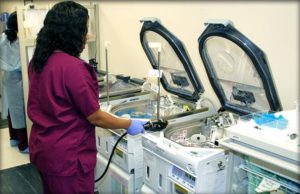 The Joint Commission (TJC) recently released a Quick Safety update titled “Improperly Sterilized or HLD Equipment – A Growing Problem”. The release was issued in response to what TJC perceives as a growing threat to patient safety. In their analysis, they state that in 2016, 74% of immediate threat to life (ITL) declarations issued by TJC were in relation to improperly sterilized or HLD equipment.
The Joint Commission (TJC) recently released a Quick Safety update titled “Improperly Sterilized or HLD Equipment – A Growing Problem”. The release was issued in response to what TJC perceives as a growing threat to patient safety. In their analysis, they state that in 2016, 74% of immediate threat to life (ITL) declarations issued by TJC were in relation to improperly sterilized or HLD equipment.
TJC also states that between 2013-2016 the rate of ITL issues related to poor sterilization or HLD practices has been on the rise. This statistical finding has been supported by surveyors who have also noticed an uptick with the issue during their onsite visits to hospitals and healthcare facilities. As this article by Lisa Waldowski at The Joint Commission explains:
“Health care organizations are struggling with standard IC.02.02.01, Element of Performance (EP) 2, which requires organizations to reduce the risk of infections associated with medical equipment, devices and supplies. EP2 is specific to HLD and sterilization, and is applicable to Joint Commission-accredited hospitals, critical access hospitals, ambulatory and office-based surgery facilities.
Noncompliance with IC.02.02.01, EP 2 has steadily escalated over the years, particularly in ambulatory and office-based surgery facilities, as well as in decentralized locations in hospitals.
Patient Safety Risks
Consequences of failed sterilization processes can result in serious outcomes, including:
- risk for contamination
- potential outbreaks, such as HIV, hepatitis B and C, and bacterial infections
- potential loss of Joint Commission accreditation
- potential loss of deeming status from the Centers for Medicare & Medicaid Services (CMS)
- negative publicity, with potential consequent revenue losses
- litigation
Common Path to Outbreaks
As an infection control specialist, I often discover that these serious outcomes result from a long-standing issue and that the true scope of the problem is not known until there is an outbreak. Many noncomplying organizations report:
- mistaken belief that the risk of passing bloodborne pathogens or bacterial infections to patients is low or nonexistent
- lack of staff knowledge or training to properly sterilize or HLD equipment
- lack of safety culture that supports the reporting of safety risks
- no dedicated staff person to oversee proper sterilization or HLD of equipment”
As threats to patient safety related to poorly sterilized or HLD equipment rise, hospitals must get in front of the problem by improving upon their existing processes. First and foremost, staff must be set up for success by ensuring that they are properly educated on the latest guidelines and techniques. Other systems, processes and overall culture must also be improved to enable the highest levels of success in the sterilization or high-level disinfection of reusable medical equipment. Hospitals that are concerned about staff adherence to protocols can turn to automation systems such as iRIScope to get better control of high-risk processes such as endoscope reprocessing. These systems improve staff compliance by standardizing processes and automating many of the data collection workflows, enabling staff to focus on the cleaning instead of the documentation.
